| Item of interest |
Information about this item and where used |
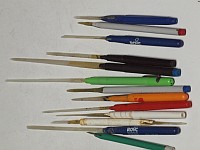
|
I have a strange habit of collecting old useless and empty rollerball and felttip pen's.
WHY???
You can make extremely handy, cheap and strong alignment tools out of them.
For every type of coil or IF transformer a special screwdriver made of PCB leftover's or scrap. Please: without the copper!
Fixed with a lick of 2-part epoxy adhesive
The ex-pen forms a luxury handgrip!
|
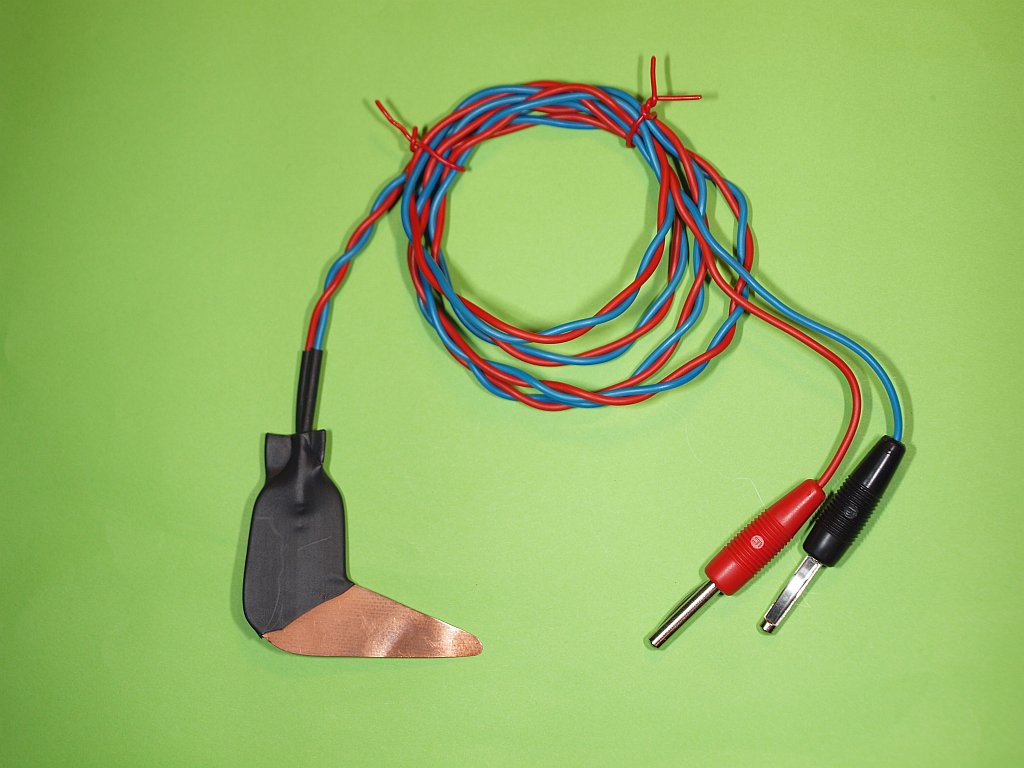
|
Current measurement trick for use in a battery compartment between batteries.
Uses a very thin double sided PCB clad shim.
Sand the edges to remove shorts
|
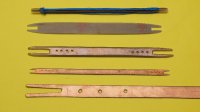
|
A toroid winding help if you are going to use a large number of windings,
so a large length of wire.
F.i. in my current transformer project with N=100.
It looks like a tool to repair fishing nets.
|
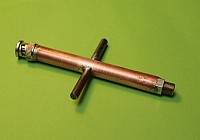
|
A "wrench" tool to mount BNC chassis parts and also to mount F connectors on coax cable.
Just a piece of 12 mm copper water pipe and a piece of a (big) 6 mm wood nail.
You don't use a soldering iron, but a gas torch to heat it up
|
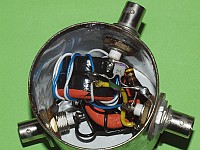
|
HF Aerial signal splitter to feed two radio's with the same signal without mutual interference.
Works from under 100 kHz to over 20 - 25 MHz. Principle like a TV-signal splitter.
It works a little higher in frequency if you use double windingwire on the orange toroid (lower leakage inductance).
Here is the UK splitter drawing in PDF.
Or drawing in a Dutch version in PDF.
Go to the page with more info about this item
|
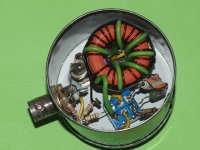
|
Impedance corrector for old tube radios connected to 50 ohms coax.
It works a little better if you use double green wire (lower leakage inductance)
UK drawing in PDF
Dutch version in PDF
Go to the page with more info about this item
|
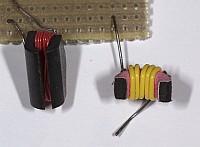
|
Some ideas to test and make wideband RF sniffers, connected to 50 ohms coax.
Go to the page with more info about this item
|
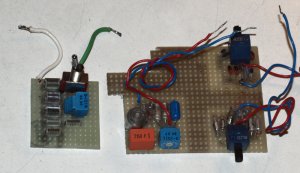
|
Hexadecial decade bank.
To obtain a low residual capacitance and in one setting a lot of values I do this with a mini hexadecimal (ABCD-)switch on a piece of experiment board. Sometimes with an extra on/off switch added. On it 4 (or 5) sets of C's in ascending values in the ratio 1-2-4-8(-16). You get rather easy 15 or 31-step linear incremental values (and step 16/32 = the value zero).
More info on the ferrite pages. See next items.....
|
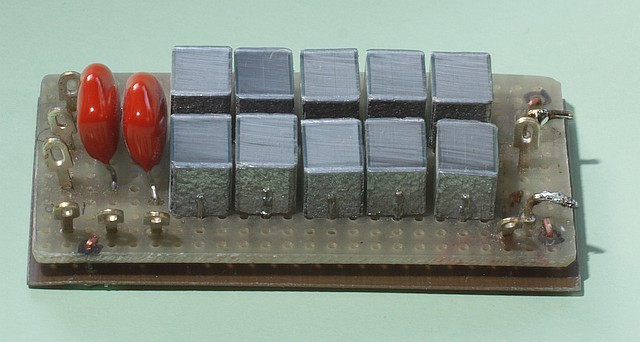
|
A very accurate test setup to measure the AL value of toroids.
You need at least 5 to ten test modules with a calibrated capacitor to perform a resonance test.
I started with the TOP-R method, but later used the TOP-C method. It has a reduced Ctop/Cpar damping influence on the max. Q.
What you see in the moving GIF are (a.o.) : 100 pF, 330 pF, 1000 pF, 3300 pF, 10 nF, 33 nF, 100 nF, 330 nF, 1000nF/1uF, 3.3 uF and 10 uF!
You not only see the newer mentioned TOP-C modules, but also some older TOP-R versions!
Go to the top of the Ferrite page and read the whole story over there.
With my software Ferricalc you can export a CSV file to import in Excel, to make curves. The equivalent parallel R curve gives an idea of the losses, the one with the highest Rp makes the ideal Rx balun toroid.
|
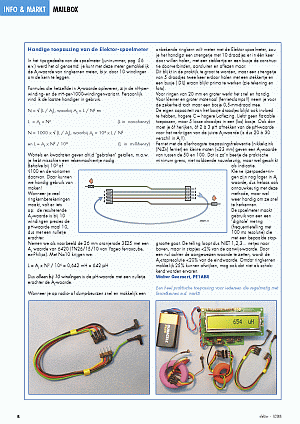
|
A very quick (and dirty) setup to measure the AL value of toroids.
Very good method for a first and quick impression of the AL value.
F.i. on hobby fairs and markets!
It is a fast measurement method with a (low frequency!) miniature coil meter and a special set of windings.
It gives a direct read-out without (almost any) calculation of the approximate AL value.
With 2x 5 = 10 windings the measured uH inductance x 10 is the AL value.
Go to the top of the Ferrite page and read the whole story over there.
This article is published in the English,
German,
French,
and the Dutch version of Elektor!
|
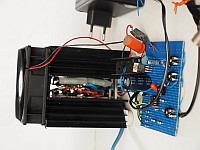
|
A current sucker device
A dynamic and adjustable heavy load for power supply torture.
YES, you read it well, can a power supply be killed, or is it really idiot-proof??
Test power supplies until they tend to oscillate (or not) or to see if the current limit is properly working! And how it behaves in current foldback mode. Also with a pulse input to make repetitive (dynamic) current pulses and to view the effects on a scope.
Here is the simple pencil-sketch of the "current sucker".
|
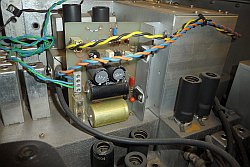
Click to enlarge the picture
|
A car radio audio-IC booster for use in a tube radio without speaker amplifier.
F.i. for use in a Racal RA-17 device.
It works on (doubled and rectified) 6.3V AC heater voltage!
AT LAST: a picture. Click on PDF icon to see the design sheets.
Or:
Go to the Radio-page with more info about this item
|
How to scan old bookpages, datasheets or schematics to create a perfect PDF.
A very short hands-on.
Much more info over here in Dutch, but with a translate option
The WWW is overcrowded with badly scanned B&W documents,
it highly irritates me!
My printed scans are as sharp as the original, or even better!
And still very low in kilobytes.
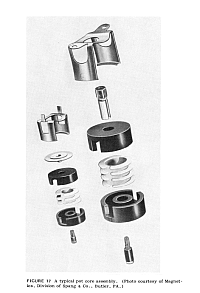
Click to enlarge the BW scan
The version in a PDF is even better!
Doesn't that look nice?
|
Whenever you use the default settings of every scan_2_pdf program or scanner interface for Black&White (B&W), you probably get very moderate to bad results. Far too low resolution (f.i. default 150 or 200 DPI = WRONG!) and much to much kilobytes, due to too many colors or gray-stages. The only proper way is to reduce the color/gray stages to 2, only black and white. The resolution should be as high as possible (permitted by the "kilobytes"), the minimum is 300 and NORMAL is 600 DPI, YES 600!! To reduce the enormous size, lossless compression should be applied, as high as possible = TIFF-G3 or preferably TIFF-G4.
This means: NEVER save an intermediate result to JPG, NEVER! Because it is NOT lossless! (and it also doesn't support 2 color)
So, if you are going to edit to remove smears, save in TIFF-G4. And also NOT in LZW. Later you drag the TIFF in Acrobat-Pro to make the PDF.
If you scan directly to PDF (from within Acrobat Professional), take care that the scanner settings are 2-color black&white and 600 DPI, and the B&W flipping point somewhere halfway. Acrobat internally automatically also uses TIFF-G4 compression to obtain the lowest kilobytes at the highest resolution.
NEVER let it reduce to 300 or 200 DPI.
B&W-pictures?? Go to 1200 DPI with reduced (lighter) flip-over point, NO gray stages for screenpixel (screen/raster) prints! Gray doesn't exist in printed B&W-matter! You only have to scan the finest pixels in pure B&W.
A two-stage method with gray/raster pictures is to scan text first as clean as possible in 2 color 600 DPI and save this one as a TIFF-G3 or G4.
Make the second picture scan as "light" as possible, and scan this one in 256-gray also in 600 DPI, save this one as a TIFF LZW. Give some "play" correction in minumum and maximum pixel setting in the histogram. Also make the scan a little less dark by pulling the middle of the curve.
Details Method 1)
So scan TWO times with the same DPI settings (=600), 2 color BW for text (a bit more black) and 256 gray for the gray raster images. Correct the gray image before the scan with histogram and/or gamma curve. Make it much "lighter", you can add this effect once more AFTER scanning. Define a new sheet in 256 gray, paste text 2 color BW-scan (with bad black image, but better black text) and over the image paste the corrected/cropped light 256 gray image. In this case save as (only!) TIFF with LZW compression.
It stays a 256 gray scan, but with perfect black-white text. And NO gray background.
Details Method 2)
Sometimes it is possible to convert the above light gray screengrid (raster) scan back to 2-color (or 16) with histogram/gamma edit. You make the background gray inbetween the black pixels white again. Convert it in a last step to pure 2 color BW, test a few settings. Than paste this good-looking (cropped) light screen picture over the muddy black text scan picture.
The result is a perfect and pure 2 color scan that can be saved as a small TIFF-G3 or G4 file.
The saved TIFF can be dragged to Acrobat Pro to make a PDF.
The printed result is also perfect.
You can see a very shockingly beautiful result of what is easily possible in a few example pages in this
PDF.
Moiré is also minimal. (Scanned from the chapter Magnetic Ceramics from the book Electronic Ceramics from Lionel M. Levinson).
Again: Without a 256-gray image save scans ONLY as TIFF, with G3 or G4 compression.
With gray, only than save as TIFF-LZW.
NEVER, NEVER, save a BW scan as JPG or as a 16 million color image.
I've processed at least more than 2500 pages by hand.
Most of it can be found on my site and over here: in the Archive.org library in San Fransisco.
|
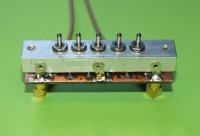
|
A very accurate 5x -10dB pad.
For 50 ohm use, totally made in SMD and extremely screened.
Has SMB click connectors.
Works excellent (from DC) to 500 MHz, usable over 800 MHz.
Go to the top of the 5x -10 dB PI-network page and read the whole story over there.
|
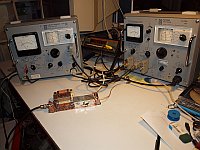
|
455 kHz IF filter measurement setup.
Uses an old Wandel & Goltermann SPM-3 and PS-3 measuring system.
Go to the NRD-515 page where the IF-filter problems are described.
The NEW measurement setup start page is over here.
Published by VERON in the magazine Electron.
|
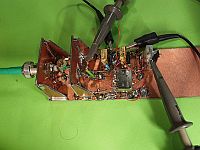
|
IF transformer test setup. A spin-off from the previous item.
To identify the characteristics of an unknown (455 kHz) IF transformer.
Also published by VERON
Direct jump to the sub page.
|
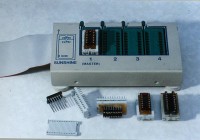
|
Many TTL-PROM read-out adapters for an Eprom-reader socket.
Suitable for many, many types of TTL-PROMs.
Designed for reverse engineering purposes.
Go to the page with more info about this item.
The TTL PROM list, a special booklet with info and footprints about allmost all old TTL PROM's.
|
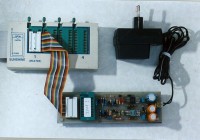
|
A 2708 read-only / read-out adapter for an eprom programmer that doesn't support this EPROM.
Designed for reverse engineering, but also upgrade purposes
(4x a 2708 bank in one 2732 in an old IDAB WAMAC newsroom stacking machine processor unit. I modified an existing 2708 EPROM card to work with one 2732 and cloned the custom version of the machine software to a spare machine. All OK!!!)
Go to the page with more info about this item.
|

|
Pulse - Echo generator box.
Go to the web page with this project.
|
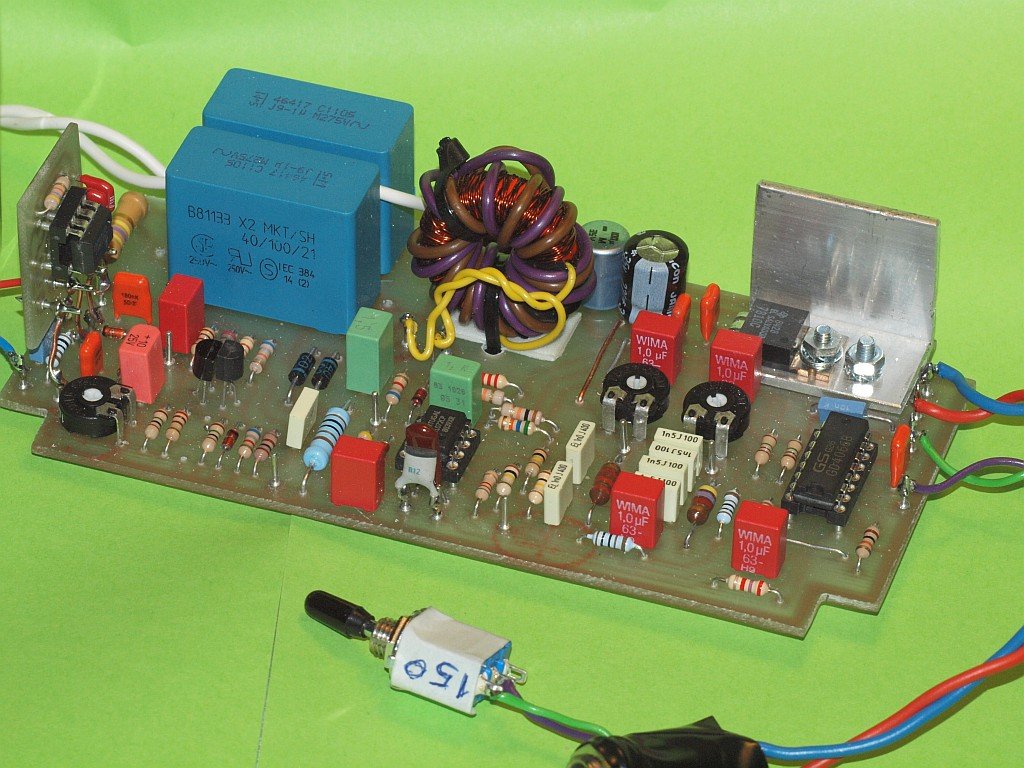
|
A NON-standard ESR meter.
Works with two different pure sine wave frequencies: 50 kHz and 150 kHz.
It has been made pretty idiot proof
Go to the web page with this project.
|
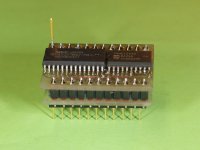
|
Functional replacement of a MCM5101 or uPD5101 CMOS RAM.
For use in very low power battery back-up circuits.
Designed to replace blown memory RAM in a JRC NDH-518 unit.
Not blown by man, but by lightning!
Go to the special web page about this project.
The original NEC uPD5101 has been available at AliExpress for a while, but not anymore. A good replacement is a Philips /Signetics version PCD5101, which IS available, see search link.
|
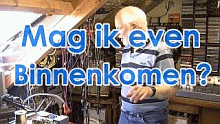
|
PE1ABR "home" video.
A short visit to the "inventors" workshop,
The circuit being designed on the table is the above ESR meter.
All the talk is in Dutch and there are no subtitles.
Play in slow motion to see all the details!!
Video Title: "May I come in for a short visit?" - part 10 - The Inventor
Video copyright:    - Daan Wallis - Daan Wallis
Web page item.
|






















